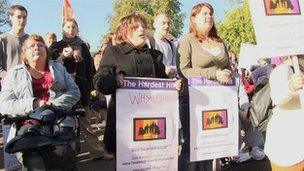Welcome to 2012. The Arab Spring, the Occupy Spring, the Indignado Spring continue. In Tunisia, Egypt, Libya, Bahrain, Syria, Yemen, and beyond, women are on the move, on the march. In Saudi Arabia, women are on the drive as well. Young women.
Across the United States and Canada and beyond, young women are leading and expanding the Occupy movement. In Chile, women high school and university students are pushing to end the privatization of education, to open the schools to freedom, democracy, universal opportunity.
In India, young rural women are leading resistance campaigns to stop major land grabs. In Afghanistan, teams of young women athletes are punching their way through centuries-old as well as recently devised glass ceilings.
In Kenya, young women are entering into local electoral politics. In Mauritius as well.
Women everywhere are on the move, keeping on keeping on, filling spaces with their voices, their bodies, their energy, their aspirations, their collective and singular power.
At the same time, women struggle with a master narrative in which they only function as sacrifices. In India, two farmers sacrifice a seven-year-old girl, Lalita, in order to ensure good crops. In Afghanistan, a fifteen-year-old girl, Sahar Gul, struggles to survive, and to live with dignity, having fled the torture inflicted on her by her husband and his mother and sister. When she first fled, the State actually returned her to `the family.’
In the United States, girls like seventeen-year-old Nga Truong, are routinely forced into confessing crimes they didn’t commit and then are sent off to prison. In the United States, seventeen-year-old girls like Samantha L. are sent to prison for life, without possibility of parole.
In Australia, teen-age girls, like Danielle Troy, have to plead for compassion rather than punishment. Their crime? Being mothers.
And in South Africa, two teenage girls are attacked by a crowd of 50 or 60 `adult’ men. Why? Because one of them was wearing a mini-skirt. Four years ago, another young woman, Nwabisa Ngcukana, was stripped and assaulted for exactly the same `crime’, at exactly the same taxi rank.
From domestic violence to more general sexual violence to mob violence to State violence and beyond, the patriarchal story of young women is the story of being-sacrificed. If a man is told, by no less than God, to sacrifice his son, we are told that is a tragedy. A moral and ethical crisis. But where is the mother of that son in the story? And what if, instead, the father was told, by no less than God, to sacrifice his daughter? Would that too be considered a tragedy? An ethical and moral crisis?
Not by the patriarchs, it wouldn’t, as the Biblical tale of Abraham and Isaac so aptly demonstrates: “It is difficult not to be struck by the absence of woman… It is a story of father and son, of masculine figures, of hierarchies among men… Would the logic of sacrificial responsibility within the implacable universality of the law… be altered… if a woman were to intervene in some consequential manner? Does the system of this sacrificial responsibility and of the double `gift of death’ imply at its very basis an exclusion of woman or sacrifice of woman? A woman’s sacrifice or a sacrifice of woman? Let us leave the question in suspense.”
Women, and in particular young women, are saying, “No.” They reject the story that excludes them and the `suspense’ that reduces them. They are saying – with their bodies, voices, actions and deeds – women and girls are not to be sacrificed. If `the Law’ says they must be, the Law is wrong. Women are making a better Law, living out a better story, and creating a better world. Another, better world is possible.

(Video Credit: WBUR)



